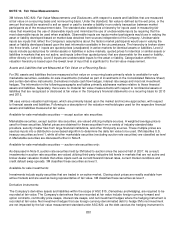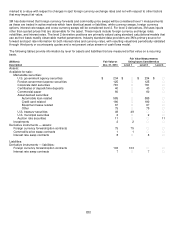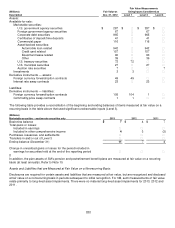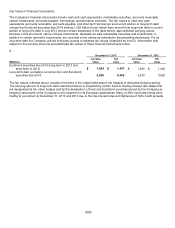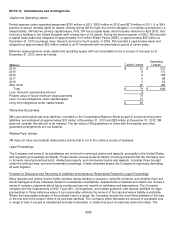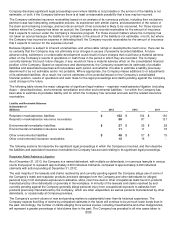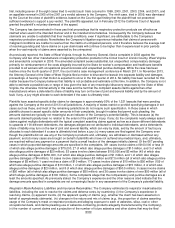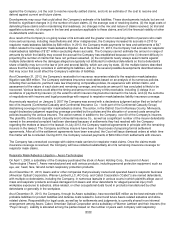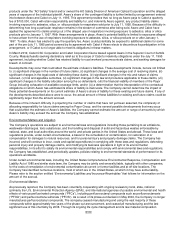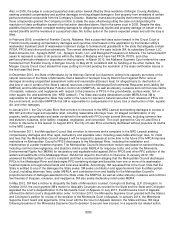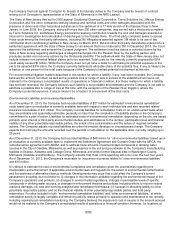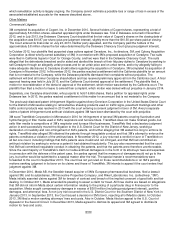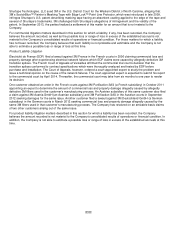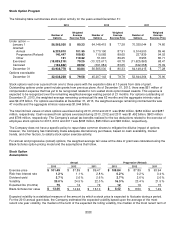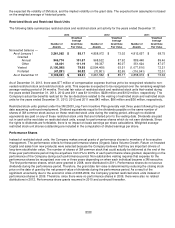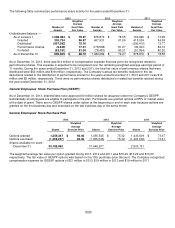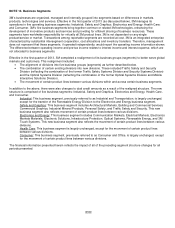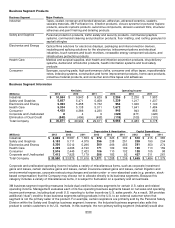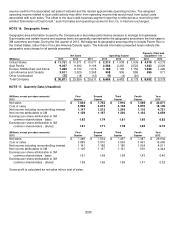3M 2013 Annual Report Download - page 113
Download and view the complete annual report
Please find page 113 of the 2013 3M annual report below. You can navigate through the pages in the report by either clicking on the pages listed below, or by using the keyword search tool below to find specific information within the annual report.107
Also, in 2005, the judge in a second purported class action lawsuit (filed by three residents of Morgan County, Alabama,
seeking unstated compensatory and punitive damages involving alleged damage to their property from emissions of certain
perfluorochemical compounds from the Company’s Decatur, Alabama, manufacturing facility that formerly manufactured
those compounds) granted the Company’s motion to abate the case, effectively putting the case on hold pending the
resolution of class certification issues in the first action described above, filed in the same court in 2002. Despite the stay,
plaintiffs filed an amended complaint seeking damages for alleged personal injuries and property damage on behalf of the
named plaintiffs and the members of a purported class. No further action in the case is expected unless and until the stay is
lifted.
In February 2009, a resident of Franklin County, Alabama, filed a purported class action lawsuit in the Circuit Court of
Franklin County seeking compensatory damages and injunctive relief based on the application by the Decatur utility’s
wastewater treatment plant of wastewater treatment sludge to farmland and grasslands in the state that allegedly contain
PFOA, PFOS and other perfluorochemicals. The named defendants in the case include 3M, its subsidiary Dyneon LLC,
Daikin America, Inc., Synagro-WWT, Inc., Synagro South, LLC, and Biological Processors of America. The named plaintiff
seeks to represent a class of all persons within the State of Alabama who have had PFOA, PFOS, and other
perfluorochemicals released or deposited on their property. In March 2010, the Alabama Supreme Court ordered the case
transferred from Franklin County to Morgan County. In May 2010, consistent with its handling of the other matters, the
Morgan County Circuit Court abated this case, putting it on hold pending the resolution of the class certification issues in
the first case filed there.
In December 2010, the State of Minnesota, by its Attorney General Lori Swanson, acting in its capacity as trustee of the
natural resources of the State of Minnesota, filed a lawsuit in Hennepin County District Court against 3M to recover
damages (including unspecified assessment costs and reasonable attorney’s fees) for alleged injury to, destruction of,
and loss of use of certain of the State’s natural resources under the Minnesota Environmental Response and Liability Act
(MERLA) and the Minnesota Water Pollution Control Act (MWPCA), as well as statutory nuisance and common law claims
of trespass, nuisance, and negligence with respect to the presence of PFCs in the groundwater, surface water, fish or
other aquatic life, and sediments (the “NRD Lawsuit”). The State also seeks declarations under MERLA that 3M is
responsible for all damages the State may suffer in the future for injuries to natural resources from releases of PFCs into
the environment, and under MWPCA that 3M is responsible for compensation for future loss or destruction of fish, aquatic
life, and other damages.
In January 2011, the City of Lake Elmo filed a motion to intervene in the NRD Lawsuit and seeking damages in excess of
$50,000 and other legal and equitable relief, including reasonable attorneys’ fees, for alleged contamination of city
property, wells, groundwater and water contained in the wells with PFCs under several theories, including common law
and statutory nuisance, strict liability, trespass, negligence, and conversion. The court granted the City of Lake Elmo’s
motion to intervene in this lawsuit. In August 2013, the City of Lake Elmo voluntarily dismissed without prejudice its claims
in the NRD Lawsuit.
In November 2011, the Metropolitan Council filed a motion to intervene and a complaint in the NRD Lawsuit seeking
compensatory damages and other legal, declaratory and equitable relief, including reasonable attorneys' fees, for costs
and fees that the Metropolitan Council alleges it will be required to assess at some time in the future if the MPCA imposes
restrictions on Metropolitan Council's PFOS discharges to the Mississippi River, including the installation and
maintenance of a water treatment system. The Metropolitan Council's intervention motion was based on several theories,
including common law negligence, and statutory claims under MERLA for response costs, and under the Minnesota
Environmental Rights Act (MERA) for declaratory and equitable relief against 3M for PFOS and other PFC pollution of the
waters and sediments of the Mississippi River. 3M did not object to the motion to intervene. In January 2012, 3M
answered the Metropolitan Council's complaint and filed a counterclaim alleging that the Metropolitan Council discharges
PFCs to the Mississippi River and discharges PFC-containing sludge and biosolids from one or more of its wastewater
treatment plants onto agricultural lands and local area landfills. Accordingly, 3M requested that if the Court finds that the
State is entitled to any of the damages the State seeks, 3M seeks contribution and apportionment from the Metropolitan
Council, including attorneys' fees, under MERLA, and contribution from and liability for the Metropolitan Council's
proportional share of damages awarded to the State under the MWPCA, as well as under statutory nuisance and common
law theories of trespass, nuisance, and negligence. 3M also seeks declaratory relief under MERA.
In May 2012, 3M filed a motion to disqualify the State of Minnesota’s counsel, Covington & Burling, LLP (Covington). In
October 2012, the court granted 3M's motion to disqualify Covington as counsel to the State and the State and Covington
appealed the court’s disqualification to the Minnesota Court of Appeals. In July 2013, the Minnesota Court of Appeals
affirmed the district court’s disqualification order. In October 2013, the Minnesota Supreme Court granted both the State’s
and Covington’s petition for review of the decision of the Minnesota Court of Appeals. In January 2014, the Minnesota
Supreme Court heard oral arguments. If the Court affirms the Court of Appeals decision, the State will have 180 days
following issuance of the Minnesota Supreme Court’s decision to secure new counsel. In a separate but related action,


